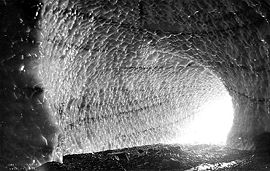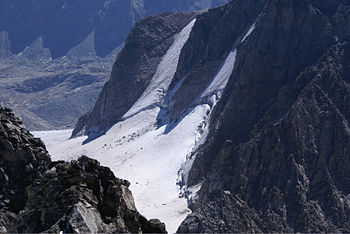Glacier
Glaciers are bodies of flowing ice that form when more snow accumulates each year than melts. Under such condition, snow turns into ice and the glacier is formed. Then, once the glacier is established, the balance between snowfall and melting determines whether the glacier retreats or advances. Due to global warming, the great majority of glaciers on earth and the two polar ice caps are in a retreat phase.
As ice flows, it erodes the surface of the land by abrasion and plucking. Sediment is transported by the glacier and deposited where the ice melts. In the process, landscape is greatly modified.
There are two major types of glaciers, continentals and valley glaciers, which produce distinctive erosional and depositional landforms. Ice caps are present today at the poles, over Greenland and Antarctica, but others were present during glaciations (e.g., over the Canadian shield and Europe). Valley glaciers are instead flowing from all major mountain chains of earth, including the Alps, the Hymalayas, the Andes and the Rocky mountains.
Glaciers are large reservoirs of fresh water, and thus a strategic resource for humanity. The present trend of rapid retreat is therefore a major reason of concern.
Definition
A glacier is a natural body of ice formed by the accumulation, compaction, and recrystallization of snow that thick enough to flow. It is a dynamic system involving the accumulation and transportation of ice. A mass of ice must move or flow to be considered a glacier. Bodies of ground ice, formed by the freezing of groundwater within perennially frozen ground, are not glaciers, nor is the relatively thin sheet of frozen seawater known as sea ice, which is abundant in the polar regions.
Formation
The essential parts of a glacial system are the zone of accumulation, where there is a net gain of ice, and the zone of ablation, where ice leaves the system by melting, calving, and evaporating. The boundary between these zones is the snow line. In the zone of accumulation, snow is transformed into glacial ice. Freshly fallen snow consists of delicate hexagonal ice crystals or needles of low density. As snow accumulates, the ice at the points of the snowflakes melts from the pressure of the snow buildup and migrates toward the center of the flake, eventually forming an elliptical granule of recrystallized ice approximately 1 millimeter in diameter. The accumulation of these particles packed together is called firn, or névé. With repeated annual deposits, the loosely packed névé granules are compressed by the weight of the overlying snow. Meltwater, which results from daily temperature fluctuations and the pressure of the overlying snow, seeps through the pore spaces between the grains; when it freezes, it adds to the recrystallization process. Most of the air in the pore spaces is driven out. When the ice reaches a thickness of approximately 60 meters, it can no longer supports its own weight and yields to plastic flow.
Types of glaciers

There are two main types of glaciers: valley glaciers and continental glaciers.
Valley glaciers are ice streams that are confined to the canyons and valleys of mountainous terrains. They originate in snowfields at the mountain crest and flow down the canyons. A valley glacier that emerges from the mountain is commonly called a piedmont glacier.
Continental glaciers are huge sheets of ice that spread over a large part of a continent. They are commonly more than 3,000 meters thick and completely cover the underlying terrain, except for the peaks of the highest mountains. The huge sheets of ice generally flow outward in all directions from one or several central regions of accumulation. Flow directions may be influenced by subglacial topography such as highlands and mountain ranges. In rugged terrain, the direction and rate of ice flow may be greatly influenced by mountain ranges, and the ice funneled through mountain passes in large streams called outlet glaciers. The ice caps of Antarctica and Greenland are present-day examples of continental glaciers with a maximum thickness approaching 5,000 meters.
Flow
Ice will flow if adequate stress is applied over an extended period of time. Gravity is the fundamental force that causes ice to flow, and where an accumulation of ice exceeds a depth of about 60 meters, depending on temperature, slope angle, and so on, flow is initiated. Ice has a higher viscosity (resistance to flow) than liquid water. As a result, its flow is not turbulent, but rather the glacial flow is laminar (the planes of flow are parallel).[1]
The ice in most glaciers normally moves too slowly to be seen at any given moment, but different experiments can demonstrate the movement of glacial ice.[2] Measurements show that various parts of glaciers move at different rates. Movement at the top is greater than at the bottom. Along with internal flow, the glacier also slips over the underlying bedrock surface. Up to 95% of the movement in a glacier occur by basal slip. Basal slip is accomplished by melting and freezing of the ice near the contact with the bedrock.[3]
Direction and amount of movement
When a glacier that is in a steady state moves, it is neither shrinking or expanding. Over a period of time, a wedge-shaped layer of snow, thickest at the head and thinnest at the snow line, is added to the surface of accumulation. A similar wedge of ice, thickest the the end of the glacier and thinnest at the snow line, is removed by melting. If a glacier is at equilibrium, the volume of water represented by these two wedges must be the same. It adjusts to the accumulation and removal of ice by changing the inclination of the direction of flow. In the zone of accumulation, the direction of movement is inclined downward, with respect to the surface of the glacier. The degree of downward inclination decreases from the head of the glacier to the snow line. At the snow line, the direction of movement is parallel to the surface of the glacier. In the zone of ablation, the movement is upward, toward the surface, with upward inclination increasing from the snow line.
